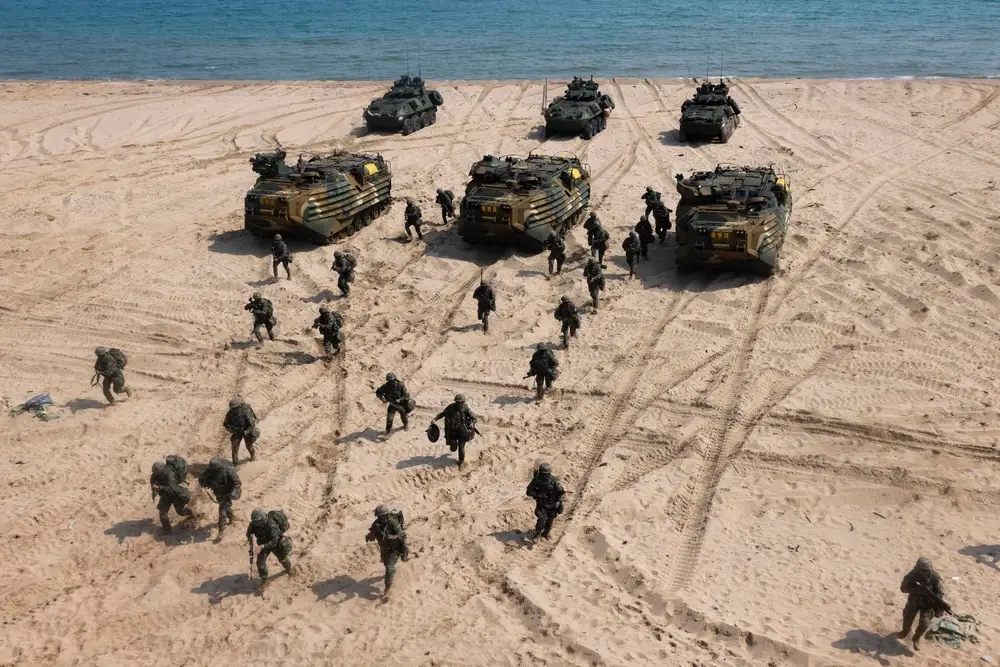The Alliance between the United States and Republic of Korea has endured the test of time for 70 years. From unforgiving conditions of Inchon and sub-zero temperatures of the Chosin Reservoir to brutal combat in the jungles of Vietnam, the U.S.-ROK Alliance has been forged through shared struggles of war and a common vision of freedom. Fast forward to present day, the 13th Marine Expeditionary Unit and Makin Island Amphibious Ready Group celebrate this Alliance through executing Ssang Yong 2023. Ssang Yong, meaning “twin dragons,” is normally a routine, bilateral exercise between U.S. and ROK Navy and Marine Corps forces, conducted in the Republic of Korea. The last full SSang Yong was conducted in 2018, which made both amphibious forces eager to be training together again. Ssang Yong 23 participants included ROK Marine Corps, ROK Navy, 13th MEU, Makin Island ARG, 40 Commando Royal Marines, and observers from France, Philippines and Australia. The week and a half long training consisted of live-fire ranges, ROKMC ranger training, comprised of fast roping and repelling, military free-fall exercises, and several subject matter expert exchanges with our ROK counterparts. The main event was an amphibious assault exercise consisting of nine ROK ships alongside the USS Makin Island, USS Anchorage, and USS John P. Murtha, as well as surface and air connectors from both U.S. and ROK amphibious forces.
“Conducting an over-the-horizon assault from the ARG is an advanced maneuver. Conducting an OTH assault as a multi-national unit under a single Commander of the Amphibious Task Force, across the same beach, demonstrates advanced capabilities as an Allied force. The last piece to this expeditionary puzzle was the aircraft overhead, deconflicting air space with ROK aviators and executing a flawless formation,” Maj. Kim Sangwoo, operations officer, ROK Marine Air Group said.
“The training involved bilateral air planning, integrated briefing and a rehearsal of concept drill. This exercise was a great opportunity to confirm interoperability of the ROK-U.S. air power.,” Capt. Jonathan Eaton, combat cargo officer, Amphibious Squadron 7 said.
“The combined force’s attention to detail and will-to-win ensured the safe execution of a near-simultaneous amphibious and aerial assault on two objectives. This event rehearsed combined forcible entry operations in the event the ARG/MEU is required to join the ROK Navy and ROK Marine Corps for combat operations,” Capt. Christian Thiessen, technical information operations officer, 13th MEU said.

The amphibious assault was a multi-faceted operation. The landing site was a concentrated beach, requiring small operational areas for the 12 Allied ships. The deconfliction of ship geometries was only part of the complicated amphibious operation, as small unit leaders within Korean amphibious assault vehicles and U.S. landing craft, air cushions deconflicted ship-to-shore movements. The amphibious assault exercise required not only the ARG/MEU team to bring their A game, but mandated the U.S.-ROK amphibious forces transcend language barriers and operate as a unified force. An extensive liaison officer network across U.S. and ROK ships was essential in creating this combined amphibious force. The 13th MEU disembarked the entirety of Battalion Landing Team 2/4 to participate in military operations in urban terrain training, close-quarters battle training, and various live-fire ranges with ROK counterparts. Also, this training is being proceeded while the Democratic People’s Republic of Korea is committing armed provocation. This is why this training is much more earnest and solemn compared to other trainings. The main focus of Ssang Yong 23 was to improve our interoperability with ROK Allies.
The language barrier was the obvious challenge during Ssang Yong 23, but we were able to bypass this obstacle through our similarities in force structure and esprit de corps. Ssang Yong 23 launched our bilateral amphibious forces toward true interoperability, through integrating U.S. and ROK Marines at every opportunity. At the closing ceremony, the III Marine Expeditionary Force Band conducted an integrated concert with the ROKMC. Our different languages and diverse instruments blended together, playing the same music, symbolized the true meaning of Ssang Yong 23. Ssang Yong 23 was a successful training evolution that not only improved interoperability between the U.S. and ROK amphibious forces, but also developed lasting relationships. These relationships and experiences help two forces come together as a synchronized team, training together side-by-side, and enhancing capabilities. For 70 years, the U.S.-ROK Alliance has remained ironclad. Ssang Yong 23 symbolizes the next step in harnessing true interoperability within this powerful Alliance.















